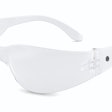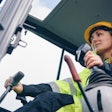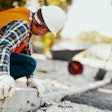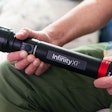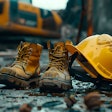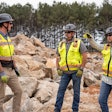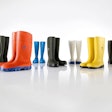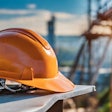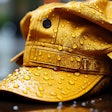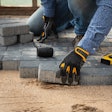
Foot apparel such as quality socks is critical to foot health, safety and comfort for working in wet conditions.
“Working in construction usually means wearing heavy, non-breathable boots/shoes and or steel toed or composite boots. These types of shoes cause feet to sweat. The worse culprit is when feet are wet from working in wet fields, in the rain, or when feet perspire,” notes Elizabeth Scheiber, DPM, Department of Orthopaedic Surgery, Cleveland Clinic Weston (Florida) Hospital.
Wearing wet socks can lead to fungal infections, Dr. Scheiber notes.
“Fungal organisms love moist and dark places,” she adds. “Many times, a rash may occur on the bottom of the feet or between the toes. Both locations can be rather itchy and uncomfortable.”
Avoid Cotton Socks
Dr. Scheiber says to avoid 100 percent cotton socks. The best sock materials for sweaty feet include antimicrobial merino wool, small fiber wool, bamboo or acrylic synthetic blends like polyester or nylon. Dr. Lance Silverman, M.D. of Silverman Ankle and Foot in Edina, Minnesota, notes wetness can increase the friction between the foot and the sock and may lead to sores and blisters.
Rashes or fungus can develop if feet are constantly in a wet sock or shoe. Keeping feet dry helps prevent issues such as athlete’s foot.
Trench foot can occur from the prolonged use of wet socks and shoes, leading to damage to the skin, blood vessels and nerves in the feet. The foot may take months to heal and may never regain some sensations if damage is extreme, Dr. Silverman notes. If socks are wet and a worker is outside in very cold temperatures for long time periods, that can cause frostbite on the toes, leading to permanent toe damage and possible amputation, Dr. Silverman says.
Dr. Scheiber offers tips to control sweaty feet and foot odor, such as using an antiperspirant with aluminum chloride roll-on or towelette. Wear breathable shoes made of canvas or mesh siding. “Although leather shoes are generally a good choice, all-leather enclosed shoes will increase perspiration. Many leather shoes come with plastic liners, which don't allow moisture to evaporate,” Dr. Scheiber says.
Air out shoes daily in a well-ventilated area. Wear different shoes on different days, she adds.
Dr. Scheiber says workers should remove insoles of the shoes at the end of the day to dry both the insole and the shoe. Insoles should be replaced often to decrease the odor within the shoe and decrease chances for fungus infection. Shoe liners may need to be changed weekly or monthly, depending on the amount of perspiration.
When not on the construction site but in a place where it is safe to do so, go barefoot or wear sandals if possible to allow feet to air out, Dr. Scheiber says.
Best Practices
Change out socks and wash and dry feet thoroughly, including between the toes, daily.
“Good foot hygiene is key in treatment,” she says.
“Use lamb's wool if you have wet, white tissue between your toes,” Dr. Scheiber says. “Placed in between the toes, lamb's wool will wick away moisture.” It is found in the pharmacy’s foot care section.
Spray or roll on an antiperspirant on feet before going to bed. Us a foot powder on feet or in shoes. Choose products with aluminum chloride, Dr. Scheiber says.
“Soak your feet in black tea water for 20 minutes a day for seven to 10 days,” Dr. Scheiber says. Use two tea bags per pint of water and brew the tea as usual. Black tea has tannic acid, which is anti-bacterial.
Feet also can be soaked in one part apple cider vinegar and two parts warm water for 20 minutes daily.
“Check your feet for fungal infection,” Dr. Scheiber says. “Peeling and scaling on the bottom of the feet and in between the toes are a classic sign of foot fungus. Increased moisture on the feet can increase the chance of a fungal infection.”
Quality Footwear
Dr. Silverman notes people should invest in a quality shoe or boot that doesn’t allow moisture in.
Pack an extra pair of socks and shoes if working in an environment where it’s likely feet might get wet. Change socks each time they get wet. Routinely inspect boots or shoes for holes.




